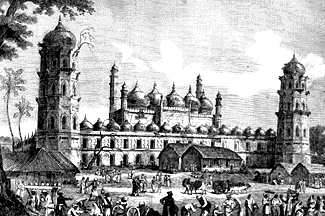| THE PALACE OF THE NAWAB OF MOORSHEDABAD |
| "In one particular Oriental architecture is greatly superior to European - that of having a picturesque sky line. In fact, the most picturesque of all the public places of Europe, St. Mark's of Venice, owes its distinction to the church having a roof on the Oriental principle. In the edifice presented on this occasion to our readers the characteristics of this style of building are shown in a most agreeable manner, the outline being symmetrical without the smallest monotony; the whole forming a palace of which the most prominent part is a mosque. Nor are those domes merely for ornament: they are the best inventions for the exlusion of heat. Long experience has shown that when an edifice has its roof composed of an agglomeration of vaulted domes the radiation of heat is effectively broken. |
| "The coolest place in a Moslem town is invariably the mosque, and in India we find many of the palaces and pavilions on this principle. Nor can we omit drawing attention to the superb towers at the angles. Originally meant for defence, they show by the originality of their architecture that they have been drawn by the designer to contribute to the ornament or the general plan. Tower, dome, colonnade - all were for real use and resistance to climate or enemies before the luxuriant fancy of the artist appropriated them to the domain of the beautiful. |
| "The juxtaposition of architectural splendor and the charms of external nature with the misery and meanness of popular life is quite characteristic of the East. With all this show of superb architecture we see the domes blistered or peeled off, and bungalows of the meanest construction thrust close to the very walls. But yet this shows us the everyday life in an Indian market-place. Under the shade of the lofty sycamore we find the female fruiterer chaffering with a purchaser, and the primitive buffalo cart unloaded and its animals reposing. The water-carrier is seen swinging his load, like our milk carriers, on the shoulder; and in the front centre we have the distended goatskin of refreshing liquor poured into the mouth of the thirsty passenger. The hookah, or, as we call it, hubble-bubble, solaces the sedentary with fumes less exciting and more agreeable than those of tobacco; and the stipendiary trooper is seen strutting about with his antiquated definsive weapons, a soldier in appearance and name rather than in reality, but an appendage to those decayed Courts which pride still retains - thanks to the liberal pension fund of the [East India] Company. |
| "The moral suggested by our Engraving is that in the residences of the native Princes a decayed barbaric magnificence is accompanied by the primitive rudeness of the indigenous population, with very little tincture of the civilization of Europe. That a great change is approaching few can doubt. Henceforth the measures of the Government must be more trenchant. Without the commission of injustice, British supremacy must assert itself with decision; and although we are not sanguine enough to say that India can be Christianised, it undoubtedly may and must be more Europeanised, and politically more centralized. |
| "Railways covering the great plains of Bengal and the Punjaub, and threading the ghauts of Southern India, will enable this large empire to be kept better 'in hand,' and a large emigration to the healthier mountain districts is clearly practicable after what we know of Ceylon, and the large and prosperous British community in the upper country of this island, which is now one vast sanitarium. With the hill countries partially settled with British, our tenure of the low country would be all the more secure. Some populations never permanently tame down in submission; but we have seen that a misplaced philanthropy makes the Hindoos rise. We have had a great lesson, and, as the smoke of crashing empire dies away, foundations of solidity are still discernible. The result we look on as the beginning of the extinction of the mere barbaric magnificence of Old India. Let the barbarism go, but let the picturesque architecture remain, nay, be extended and revived, by the future Pugins of the Eastern Hemisphere." |

